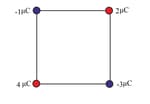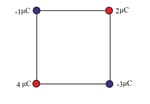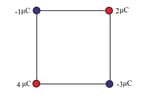Four equal charges are placed at the vertices of a square side of .
Determine the electric field at the centre of the square.

Important Questions on Fields (HL)
Four equal charges are placed at the vertices of a square side of .
How do you reconcile your answer to part question and part question with the fact that the electric field is the derivative of the electric potential
Four charges are placed at the vertices of a square of side , as shown in the diagram.

On a copy of the diagram, show the forces acting on charge. Find the magnitude and the direction of the net force on the charge. (use .)
Four charges are placed at the vertices of a square of side , as shown in the diagram.

Calculate the value of the electric potential at the centre of the square (use .)
Four charges are placed at the vertices of a square of side , as shown in the diagram.

Determine the work that must be done in order to move a charge of initially at infinite to the centre of the square. (use .)
Two conducting spheres are separated by a distance that is large compared with their radii. The first sphere has a radius of and has a charge of on its surface. The second sphere has a radius of and is neutral. The spheres are then connected by a long conducting wire.
Find the charges on each sphere.
